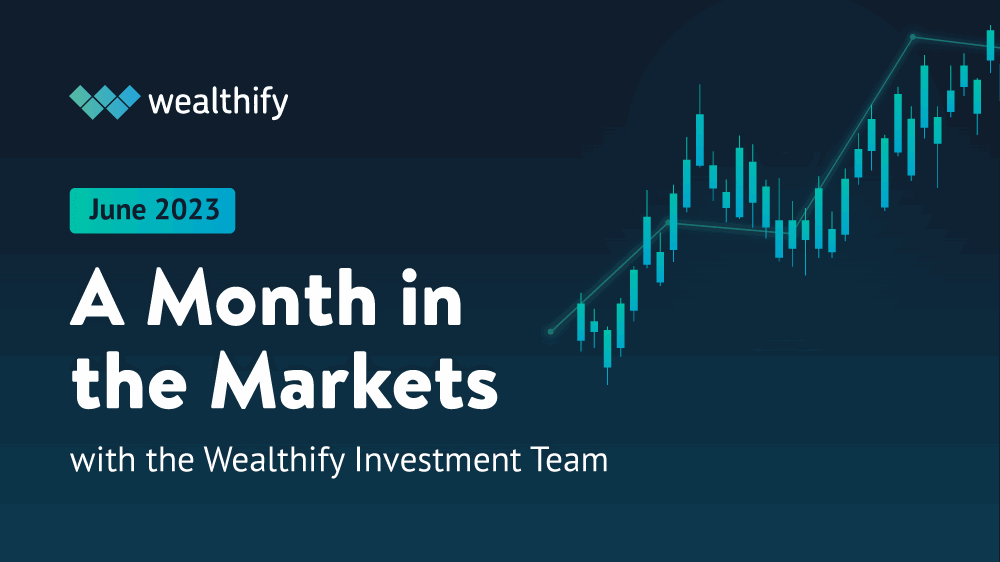The Month in a Minute
📰 Overall: Global share markets improved in June, capping off a decent first half of 2023.
💪 Benchmark Performance: Our Plans continued to outperform their benchmarks in June and the first half of 2023.
📈 Market Movers: Japanese shares (+7.4%); FTSE 250 (-1.6%).
📋 Plan Summary: Plans with a higher allocation to shares performed better than those with a higher allocation to lower-risk assets.
🌍 Original Plans: Shares (+2.4%); bonds (-1.0%).
🌳 Ethical Plans: Shares (+2.0%); bonds (-1.0%).
⏲ Going Forward: We’ll continue to proceed with caution, favouring more defensive shares.
Global share markets improved in June, capping off a decent first half of 2023. However, we continue to proceed with caution, meaning we’ll still be very selective in favour of more defensive shares.
Even though rising interest rate expectations (on the back of stronger-than-expected economic data) saw lower bond prices in June, we do continue to favour bonds in our Plans based on two factors:
1.) We believe we are near or at the peak of interest rates in the developed world.
2.) The strong reward for risk bonds offer, in times when the economy and corporate earnings come under pressure.
Despite this positioning, our Plans continued to outperform their benchmarks in June and the first half of 2023, with asset selection a key driver of solid relative performance. So far, the positive state of global economic growth has had differing impacts on shares and bonds in 2023. Shares have rallied, as belief that the global economy can avoid a recession has grown.
Bonds, on the other hand, have moved down as interest rate expectations have risen on the back of stubborn inflation.
We think the view on shares, however, is somewhat too good to be true. Why? Because greater-than-expected growth is likely to lead to similar inflation and, in turn, higher interest rates (which will eventually impair growth, corporate earnings, and share prices).
The health of any economy is underpinned by consumer spending which, in turn, is underpinned by consumer confidence, credit conditions and, crucially, the labour market. Healthy corporate and household balance sheets have delayed the impact of interest rate rises on both spending and hiring, which have increasingly become concentrated in the services as manufacturing activity has declined.
As interest rates continue to rise – and these savings and credit are harder to come by – the threat of unknown economic consequences increases.
"Our goal in these uncertain conditions? To diversify as much as possible to protect capital, while maintaining healthy upside potential through carefully selected exposures."
— Kyle Cox, Deputy Chief Investment Officer
In the US, inflation was down from the previous month (4.9%), settling at 4.0%. This strong downturn came mainly from the disinflation related to oil prices, which peaked in June last year. Core inflation (which excludes more volatile components such as energy) came in ahead of expectations at 5.3%. This will continue to bother the US Federal Reserve (The Fed), promoting higher interest rates for longer to reduce the risk of more permanent inflation.
One of the main worries will be wage inflation, which is inherently linked to the labour market. The US jobs report beat expectations yet again. This was a key driver of the upward shift in interest rate expectations, with investors again concerned the Fed will have to raise rates further. This rate raise would seek to cool the jobs market to drive service or wage-driven inflation meaningfully down to long-term targets.
In Europe, inflation resumed its downward path after a slight uptick in the previous month. Headline inflation fell from 7.0% to 6.1%; core inflation – which excludes energy – fell slightly from 5.6% to 5.3%. The economy is cooling, with manufacturing contracting and services now also beginning to slow down. Despite this, the core inflation numbers are likely to promote further hikes by the European Central Bank (ECB) into the summer.
Closer to home, UK inflation was unchanged from the previous month at 8.7%. The Bank of England’s (BOE) reaction was an unexpected 0.5% interest rate hike, with the market expecting 0.25%. The main concern for the BOE and market, was the greater-than-expected rise in both core and services inflation, which tend to be more persistent drivers of inflation.
A very tight labour market is one of the key drivers of these inflation sources. After a slight softening in May, the number of employees on payrolls increased by 23,000 in June, which was in line with expectations. Due to the UK benefitting less from disinflationary forces than the US and Europe, more will need to be done by the BOE to bring inflation into acceptable ranges quicker.
Markets
In June, global shares delivered a healthy return of 5.6%, while global bonds were flat. Developed market shares (5.9%) outperformed emerging market shares (3.2%), the main driver of this disparity being the strong performance of US and Japanese share markets.
The recent AI-driven rally of selected US tech stocks broadened in June, with all sectors showing positive performance. This saw the US S&P 500 index post a gain of 6.5% in June.
Japan again showed strong performance (+7.4%). A large portion of Japanese companies earn the bulk of their profits abroad, and the weakness in the yen has significantly increased the value of these shares in the local market.
European shares (+2.3%) claw back some of the previous month’s losses, but UK shares provided a mixed bag. The FTSE 100 ended the month up 1.1%, while the smaller FTSE 250 ended it down 1.6%. The UK and, to a lesser extent, Europe, remain locked in a battle against inflation, which has weighed on any positivity. While the US is certainly not out of the woods on the inflation front, the progress that’s been made has helped fuel more positivity among investors.
Currency
Shifting interest rate differentials on the back of fresh economic data drove currency shifts in June. Greater risk appetite was a factor, too, as the US dollar lost value against most major currencies. Sterling benefitted from this trend, appreciating by 2.1% against the US dollar in June. Sterling also appreciated strongly against the yen (5.7%), while it was flat against the euro.
Investment type performance breakdown
In our Original Plans, shares (+2.4%) delivered positive returns, driven by strong returns from the US, which was enhanced by sterling hedging. Bonds (-1.0%) delivered negative returns, mainly due to rising bond yields in the UK.
Ethical shares provided similar performance, with shares (+2.0%) also positive and driven by US share exposure, particularly the sterling hedged portion. Bonds (-1.0%) also struggled, as yields ticked up.
Summary with Plan details
In June, Plans with a higher allocation to shares performed better than those with a higher allocation to lower-risk assets.
Our Investment Team continues to actively monitor the financial markets and their impact on your Plan — and are always ready to act in your best interests to events as they unfold.
We are continually evaluating new market information and key market drivers to help keep your Investment Plan on track.
It’s important to remember that it’s normal for markets to go up and down, with periods of volatility to be expected when you invest. As always, we continue to look for opportunities to position your investments, with the goal of protecting your money and achieving your long-term objectives.
Wealthify does not provide financial advice. Please seek financial advice if you are unsure about investing.
Please remember the value of your investments can go down as well as up, and you could get back less than invested. Past performance is not a reliable indicator of future results.



